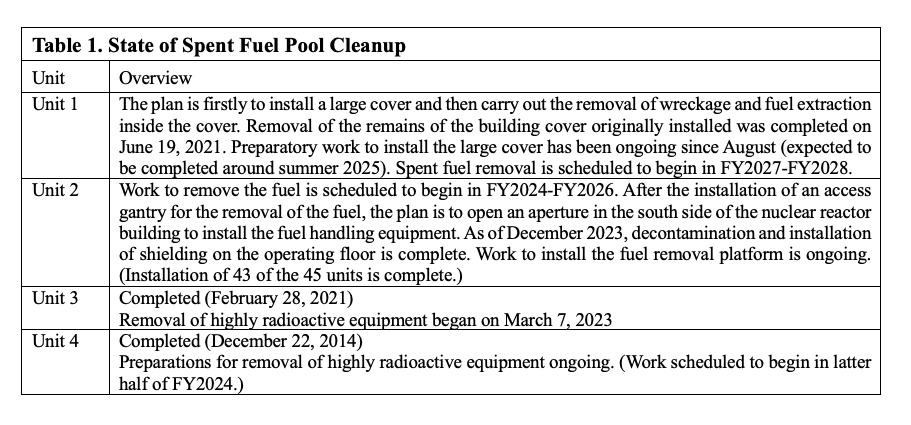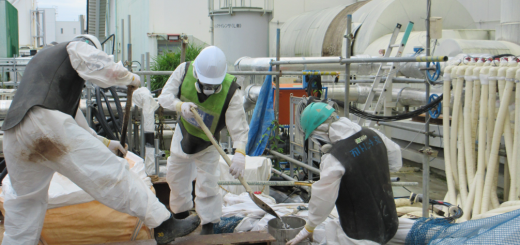Current State of Post-Accident Operations at Fukushima Daiichi Nuclear Power Station
(Oct. 2023 to Jan. 2024)
By Matsukubo Hajime (CNIC)
State of the Plant
The water temperature in the containment vessels and the spent fuel pools (SFPs) shows no great variation despite seasonal temperature changes. The state of releases of Xenon-135 (half-life roughly nine hours), released when uranium fuel undergoes fission, is also unchanged and it can therefore be estimated that the state of the reactors is stable. Further, around 13,000 becquerels per hour (Bq/h) of radioactive materials were being released to the atmosphere from the buildings (TEPCO assessment in December 2023, Fig.1).
Fig. 1. Radioactivity from Units 1 to 4 of Fukushima Daiichi Nuclear Power Station (Bq/h) released to the air

At the same time, decay heat has fallen greatly with the passage of time, and thus the volume of cooling water injected into the reactors has been reduced (falling from 7-10m3 per hour in May 2011 to 1.3-3.8m3 per hour as of December 2023).
The state of removal of spent nuclear fuel from the SFPs is summarized in Table 1. Spent nuclear fuel removal from Units 3 and 4 has been completed. Preparations are now being made to remove the spent nuclear fuel from Units 1 and 2.
The removal of fuel debris has been delayed. Experimental removal using a removal device (a folding robot arm of 22m in length) originally scheduled in the Mid-term Roadmap to take place in Unit 2 in FY2021 has been delayed (for the third time) until October 2024. Having been delayed due to the COVID-19 infection and then malfunctioning of the removal device, trouble has also been experienced opening the reactor vessel penetration hatch (X-6 penetration) to be used to insert the device. The hatch having been opened, it was found that cables, etc. inside the penetration, which melted during the accident, have fused and are lying in a heap. TEPCO built a device to push away the accumulated material using machinery and water (scheduled to be completed at the end of FY2023). The plan now is to use an experimental telescopic-type removal device, differing from the robot arm removal device, that can be inserted into the hatch without removing the accumulated material. This device will be used to extract debris on an experimental basis by October, and then from the end of FY2024 through to FY2025 the robot arm removal device will also be used to extract debris. In addition, investigations are ongoing due to water level reductions occurring in the Unit 1 pressure containment vessel (PCV) and Unit 3 PCV and suppression chamber.
Changes in the average number of workers onsite per day is shown in Fig.2. As of December 2023, the number of workers was 4,640. The number of reports of non-compliant work cases is trending downwards (Fig.3. G1 (grade 1) indicates the most serious non-compliance cases).

State of Contaminated Water
Contaminated water countermeasures at Fukushima Daiichi Nuclear Power Station (FDNPS) can be broadly divided into three areas: 1) Reduction of groundwater flowing into buildings, 2) Reduction of contaminated water flowing into the sea, and 3) Reduction of the toxicity of contaminated water. The main countermeasures to reduce water inflow into the buildings are, from higher elevations downward, (A) Pumping up groundwater at the groundwater bypass and releasing it into the sea (878,307m3 up to February 16, 2024), B) Installation of a frozen earth barrier (on-land water barrier, total length roughly 1,500m) surrounding FDNPS Units 1-4. C) Pumping up water at the subdrains and releasing it into the sea (1,639,594m3 up to February 15), and D) Paving of the site with asphalt to suppress permeation of rainwater into the soil. Measures to prevent the discharge of contaminated water into the ocean include A) Groundwater leakage prevention by a steel water barrier on the sea-side, B) Pumping up of groundwater dammed up behind the sea-side water barrier from the well points and groundwater drains. Due to these measures, the volume of contaminated water discharged, 540m3/day in May 2014, fell to 90m3/day in FY2022, partly due to the fact that there were no intensive rainstorms during that year.
In the reduction of the toxicity of contaminated water, cesium and strontium are removed, and after the removal of impurities using a reverse osmosis (RO) membrane, 62 radionuclides are then removed by the multi-radionuclide removal equipment (ALPS – Advanced Liquid Processing System). The water is then stored in tanks (containing 1,329,299m3 as of February 8, 2024. However, due to past equipment malfunctions and operational policies, around 65% of the stored water exceeds the notification concentration). Oceanic release of the ALPS-treated contaminated water began on August 24, 2023, a total of 23,351m3 being released in three batches by January 2024. Further, roughly 10,390m3 of water remain in buildings, as well as 8,112m3 strontium-treated water, etc., 5,922m3 water treated by RO, and 9,368m3 concentrated wastewater, etc. also exist onsite.
Cleaning work incidents occur in quick succession
On October 25, 2023, a radiation exposure accident occurred in the expanded ALPS, one of three ALPS systems, during cleaning work (See here for detailsTwo Accidental Exposure Incidents at Fukushima Daiichi). Further, on February 7, 2024 water was seen to be leaking from the ventilation aperture (a vent about 5m above ground level on the east wall of the high-temperature incinerator building) of the No.2 cesium adsorption instrument (SARRY). An open-valve inspection was scheduled, but prior to that filtered water was flushed through the system to reduce the dose rate. It is said that, at that time, as work was initiated with filter and adsorption tower drain valves (10 locations) open when they should have been closed, filtered water leaked out by backing up into the vent line. The amount of the leakage was assessed at 1.5m3, containing a total of 6.6 billion becquerels of Cs-137 and Cs-134. The surface immediately below the ventilation aperture is covered with concrete, but only a few dozen centimeters away the ground is covered with coarse gravel and the leaked water is thought to have seeped into the ground there. The TEPCO plan is to retrieve the soil until the ground surface dose rate reaches an average of 0.020mSv/h or less (equivalent to the background dose rate in the surrounding area) and has removed approximately 20m3 of soil from the coarse gravel area as well as removing some asphalt paving and retrieving soil (approximately 7m3) (See Fig.4). Further, when the soil below the concrete immediately below the leak was examined, as the dose rate was found to be around 7mSv/h, soil was also removed from under the concrete area.

The work was implemented with the workers using “point and call” and other safety practices, but with the bewildering procedure manual and the high dose rate, the failure to notice that the valves had not been closed was probably due to the workers and staff wishing to get the job done as quickly as possible. TEPCO says it will revise the procedure manual and change the ventilation aperture outlet to a different location.
The accident at the extended ALPS system and the problem at the No.2 cesium adsorption instrument both occurred in association with work mistakes. Even if the occurrence of such mistakes is reduced, it will be difficult to reach zero. At the same time, what is of concern is work procedures that very often involve workers doing work by hand, as seen, for example, in the extended ALPS cleaning work. In the day-to-day work of decommissioning of Fukushima Daiichi Nuclear Power Station (FDNPS), it is thought that a great amount of makeshift work is being carried out onsite as a result of the various kinds of difficulties faced. In addition, sometime in the near future work will begin on the removal of fuel debris, considered to be quite difficult work involving very high exposure rates. The current state of work is severe, but when debris removal is added to that, one wonders whether TEPCO will really be capable of managing the work at FDNPS.
The problem will be in the 30 to 40 years to the end of the measures to decommission the plant, in other words, in the Mid- to Long-term Roadmap that calls for decommissioning measures to be completed in 2051. This decommissioning only adds to TEPCO’s woes, as there is absolutely no profit to be made from it. Having to implement the decommissioning within the scope of the remaining 27 years makes it extremely hard for TEPCO to devise a truly robust work plan. As a result, work onsite is makeshift, and we believe that this leads to an amplification of risk.
This is not just TEPCO’s problem. The government, the author of the Mid- to Long-term Roadmap, also bears a great responsibility for this. Is it that if FDNPS is rapidly decommissioned, that will be deemed the “restoration” of Hamadori (the coastline region of Fukushima Prefecture)? It is meaningless to cause external leaks of radiation through further work mistakes. An immediate re-examination of the risks of rushed decommissioning is needed.




